Balkinization
an unanticipated consequence of
Jack M. Balkin
Balkinization Symposiums: A Continuing List
E-mail:
Jack Balkin:
jackbalkin at yahoo.com
Bruce Ackerman
bruce.ackerman at yale.edu
Ian Ayres
ian.ayres at yale.edu
Corey Brettschneider
corey_brettschneider at brown.edu
Mary Dudziak
mary.l.dudziak at emory.edu
Joey Fishkin
joey.fishkin at gmail.com
Heather Gerken heather.gerken at yale.edu
Abbe Gluck abbe.gluck at yale.edu
Mark Graber
mgraber at law.umaryland.edu
Stephen Griffin
sgriffin at tulane.edu
Jonathan Hafetz
jonathan.hafetz at shu.edu
Jeremy Kessler
jkessler at law.columbia.edu
Andrew Koppelman
akoppelman at law.northwestern.edu
Marty Lederman
msl46 at law.georgetown.edu
Sanford Levinson
slevinson at law.utexas.edu
David Luban
david.luban at gmail.com
Gerard Magliocca
gmaglioc at iupui.edu
Jason Mazzone
mazzonej at illinois.edu
Linda McClain
lmcclain at bu.edu
John Mikhail
mikhail at law.georgetown.edu
Frank Pasquale
pasquale.frank at gmail.com
Nate Persily
npersily at gmail.com
Michael Stokes Paulsen
michaelstokespaulsen at gmail.com
Deborah Pearlstein
dpearlst at yu.edu
Rick Pildes
rick.pildes at nyu.edu
David Pozen
dpozen at law.columbia.edu
Richard Primus
raprimus at umich.edu
K. Sabeel Rahmansabeel.rahman at brooklaw.edu
Alice Ristroph
alice.ristroph at shu.edu
Neil Siegel
siegel at law.duke.edu
David Super
david.super at law.georgetown.edu
Brian Tamanaha
btamanaha at wulaw.wustl.edu
Nelson Tebbe
nelson.tebbe at brooklaw.edu
Mark Tushnet
mtushnet at law.harvard.edu
Adam Winkler
winkler at ucla.edu
Compendium of posts on Hobby Lobby and related cases
The Anti-Torture Memos: Balkinization Posts on Torture, Interrogation, Detention, War Powers, and OLC
The Anti-Torture Memos (arranged by topic)
Recent Posts
Election as a Distinct Sphere Under the First Amendment
Just A Few Blogs
ACS Blog
Alas, a Blog
Althouse
Arts and Letters Daily
Atrios (Eschaton)
Bill of Health
Buzzflash.com
Buzz Machine
Cato at Liberty
Juan Cole (Informed Comment)
Concurring Opinions
The Constitution in 2020
Corrente
Crooked Timber
Daily Howler
Daily Kos
Dana Boyd
Brad DeLong
Digby (Hullabaloo)
Discriminations
Daniel Drezner
Kevin Drum (Mother Jones)
Electrolite
En Banc
Eunomia (Daniel Larison)
Fafblog
Michael Froomkin (Discourse.net)
GovLab (Beth Noveck)
Rick Hasen (Election Law)
History News Network
How Appealing
Ignatz (Sam Heldman)
The Importance of (Ernie Miller)
Infolaw
Instapundit
International Economic Law and Policy Blog
IntLawGrrls
Jacob Levy
Jesus' General
Jurisdynamics
The Kitchen Cabinet
Mark Kleiman
Law Blog Central
Larry Lessig
Lawyers, Guns and Money
Liberal Oasis
Brian Leiter's Law School Reports
The Leiter Reports
Marginal Revolution
Megan McArdle
Memeorandum
Metafilter
Mirror of Justice
The New Republic
Newseum
No More Mister Nice Blog
Brendan Nyhan
Opinio Juris
Orcinus
The Originalism Blog
Pandagon
Passport (Foreign Policy)
Overcoming Bias
Political Animal (Washington Monthly)
Political Theory Daily Review
Political Wire (Taegan Goddard)
The Poor Man
Virginia Postrel
Prawfsblawg
Public Reason
Jonathan Rauch
Raw Story
Redstate
ReligiousLeftLaw.com
Reporters Committee For Freedom of the Press
Reproductive Rights Blog
Rothman's Roadmap to the Right of Publicity
SCOTUS Blog
Seeing the Forest
Clay Shirky
The Shifted Librarian
The Situationist
Larry Solum (Legal Theory)
Andrew Sullivan
Talking Points Memo
Talk Left
Tapped
Tbogg
TechPresident
The Paper Chase (Jurist)
Tom Paine
Tom Tomorrow (This Modern World)
Eve Tushnet
Uggabugga
University of Chicago Law School Faculty Blog
Unqualified Offerings
The Volokh Conspiracy
War and Piece (Laura Rozen)
Wampum
Oliver Willis
Wonkette
Written Description
Matthew Yglesias
Yin
Your Choice of Feeds
1. XML
powered by
2. Atom Feed
3. RSS 2.0
Election as a Distinct Sphere Under the First Amendment
Guest Blogger
For the Balkinization symposium on Free Speech in Crisis and the Limits of the First Amendment. Richard H. Pildes [This is an excerpt that bears on the general themes of this conference from an essay I published in Money, Politics, and the Constitution (2011). I also want to acknowledge the influence of my sorely missed friend, Fred Schauer, including from our co-authored article Electoral Exceptionalism and the First Amendment, 77 Tex. L. Rev. 1803 (1999).] … The primary goal of this essay is to explore the possibility of electoral exceptionalism, rather than to evaluate any particular laws or policies that could be applied to elections as a result. Competing Conceptions of Rights That there is some “normal” or “standard” conception of what First Amendment doctrine does is widely believed. This off-the-rack understanding of the doctrine, centrally informed by such icons of the First Amendment tradition as Brandenburg v. Ohio, New York Times Co. v. Sullivan, New York Times Co. v. United States (The Pentagon Papers case), Cohen v. California, and Texas v. Johnson is thought to represent the essential form of First Amendment protection. Departures, generally in the direction of less rather than more stringent protection, are routinely denigrated as exceptions. We often hear the argument from the Supreme Court and others that these and other cases establish something like a compelling interest standard for any regulation of speech, that the compelling interest standard is practically unattainable, and thus that any proposal for regulation of campaign- related speech or expenditures would be tantamount to carving out an exception from the First Amendment. This view tends to be associated with an individualist conception of the purposes of the First Amendment. If the First Amendment protects rights intrinsic to essential attributes of individual personhood, autonomy, or dignity, such as the right to self-expression, it is easy to see how one might conclude that First Amendment “rights” should not depend in significant ways on the particular contexts in which they are asserted. That many might think the First Amendment should be understood in this way comes as no surprise. Much of American constitutional law, not just the First Amendment, is cast in the language of protecting individual rights: rights to democratic participation, rights to equality, or rights to freedom of belief. Indeed, the most influential metaphor for the way constitutional rights are often thought to work is the imagery that legal philosopher Ronald Dworkin conjured up of rights as “trumps.” Dworkin argued that rights protect individual interests by excluding majoritarian preferences or judgments about the common good as a justification for limiting rights. As Dworkin put it, “If someone has a right to something, then it is wrong for the government to deny it to him even though it would be in the general interest to do so.” This perspective is easily read to portray constitutional cases as entailing direct conflicts between individualistic interests (in liberty, autonomy, personhood, or dignity) and majority judgments about the common good—with constitutional rights trumping the latter to secure the former. There is, however, an alternative “structural conception of rights.” On this view, rights are a means of realizing various common goods, rather than being protections for individualist interests against collective judgments about those common goods. Rights do protect the interests of the rights holders, but not only those interests; the protections that rights bestow are not justified because they protect these individualistic interests, but because rights protect various spheres or domains from governmental intrusion on the basis of constitutionally impermissible reasons. Rights are not general trumps against appeals to the common good; instead, they are better understood as channeling the kinds of reasons that government can invoke when it acts in certain areas. In this structural conception, rights function as linguistic tools that the law invokes in the pragmatic task of bringing certain issues before the courts for judicial resolution. Rights exclude government action within certain contexts in order to preserve the normative integrity of various domains, as constitutionally delineated. So, rights protect a certain conception of public education; they protect a certain conception of religion and the boundary between religion and the state; they protect a civil-service bureaucracy from the intrusions of partisan politics; they define the appropriate structure of the sphere of democratic politics; and they protect other spheres from state intrusion on the basis of impermissible purposes. Far from standing opposed to the pursuit of various common goods, rights are the tool through which constitutional law creates and preserves common goods, such as democratic education, politics, religion, public service, and other domains that help realize various social values. In other words, rights help create a constitutional culture by differentiating various domains from each other and precluding the state from acting on certain reasons in some of these domains, even if those same reasons could properly form the basis for state action in other domains. This structural conception of rights is deeply rooted in the American idea of constitutionalism itself. This idea did not begin with philosophical conceptions of the person and reason out from there to rights. It was rooted in the experience of government, both English colonial administration and state governments after the Revolution. American constitutional rights are better pictured, at least in origin, as reasoning “in” from judgments about government to constitutional barriers erected to avoid what past practice had made all too visible: the corrosive potential of government. Rights were not designed to protect individuals in their atomistic interests in, for example, self- expressiveness; rather, rights were designed to sustain a political culture in which “public liberty” was enhanced by recognizing certain domains as relatively autonomous. This conception meant defining certain domains as off-limits to state action that rested on particular, impermissible purposes. Domains for First Amendment purposes are not empirical facts, nor brute conventions, that require no further acts of legal interpretation. Instead, they are ongoing social practices, constituted in part by past legal understandings, whose meaning consists of critical reflection on those practices on the basis of standards that are at least partly internal to the practice itself. Even when the claim is that a new domain ought to be recognized under the First Amendment, that claim is likely to be made on the basis of analogizing from existing legal understandings or from interpretations of the practice as it currently exists. The critique of the individualist account of First Amendment rights offered here is one of existing practice that conceptualizes the First Amendment at too abstract a level of generality in relation to the social and economic practices the First Amendment seeks to regulate and evaluate. There is no general right of free speech. There is no one general value or interest that free speech protects. There is no realm of action of undifferentiated liberty called freedom of speech. When the Supreme Court, commentators, or participants in public discourse suggest otherwise, they are reifying free speech into an overly abstract conception. First Amendment public discourse has drifted toward too high a level of abstraction and generality—a level that cannot make sense of the actual cases themselves. Actual First Amendment practice depends upon a considerably more embedded understanding of speech, one that recognizes speech interests to be contingent upon the specific social context. Elections as Bounded Spheres With respect to elections and regulation of campaign finance, then, the question is not whether such regulation intrudes on some abstractly conceived individualistic interest in liberty or self- expression. It is whether the domain of electoral politics should be recognized as a domain distinct, for First Amendment purposes, from other domains, such as the general sphere of public discourse. Elections are already highly structured spheres, including regulations that would be impermissible in the general domain of public discourse. There are limits on what voters are permitted to express at the ballot box; mandatory disclosure obligations on the identity of political speakers; content- based regulations of electoral speech, ranging from mundane constraints such as electioneering near polling places to more dramatic ones, such as selective bans on contributions from some speakers (for example, corporations); and a series of other constraints. Moreover, elections are already structured in many ways that could be conceived as impinging upon constitutional rights other than those in the First Amendment. For example, what considerations justify requiring that voting be viva voce, as in the late-eighteenth century, or by open balloting, as it was through much of the nineteenth century, or by the secret balloting process that did not become widespread in America until the late-nineteenth century? Any of these choices prefer some modes of electoral practices over others on the basis of judgments about “better” forms of democracy. Are the rights of self- expression, free speech, or the right to vote, violated by any of these choices? We do not stop to consider that a serious question, though it could be. The justification of these structures is that they promote a “fairer” mode of representation, that they enhance the deliberative quality of choosing candidates and making policy, or that they improve the quality of voter decision-making. These are precisely the kinds of justifications that would be offered for some types of campaign finance reform. The question of how to finance elections currently looms large as a unique problem in constitutional theory partly because we have come to suppress awareness of many background decisions previously made about other crucial elements of the electoral structure. In other words, elections are already extensively regulated, state- structured processes; this structuring is designed to achieve specific instrumental purposes. From a constitutional perspective, decisions about whether to structure the financing of elections are not so obviously different from other decisions that are currently far less controversial about how to structure elections. The argument from electoral exceptionalism would draw upon the understandings already embedded in the way elections are legally constructed. Arguments that the First Amendment should recognize a distinct set of principles to evaluate speech regulations in the electoral context would draw upon the understandings already embedded in the way elections are legally constructed. To the extent values of individual self-expression play a role in the best constitutional understanding of various domains, they are one factor in the legal analysis, but always in relation to the social values that are argued to constitute distinct institutional domains. The First Amendment as Unitary or as an Exception In the First Amendment context, the argument that there is a general, “normal” conception of free speech rights that applies the same way in nearly all contexts—an argument associated with the individualist justification of constitutional rights—is long on rhetoric and short on substance. Even if we accept the claim that money is speech, it does not follow that identifying a restriction as a restriction of speech necessarily puts us within the domain of the First Amendment. Almost all the law of contracts, warranties, labels, wills, deeds, trusts, fraud, and perjury, as well as much of antitrust law, securities law, and consumer law, is accurately seen as a regulation of speech in the literal sense of that word, yet exists without even a glimmer of First Amendment scrutiny. In most of these instances, the claim that the First Amendment is even relevant would generate little more than quizzical judicial disbelief. Once we see that the overwhelming proportion of speech is not covered by the First Amendment, and the overwhelming proportion of speech regulation not touched by the First Amendment, we can see the rhetorical sleight-of-hand implicit in the standard talk of “exceptions” to the First Amendment. In reality, the First Amendment itself might better be seen as an exception to the prevailing principle that speech may be regulated in the normal course of governmental business. A more plausible but still unsound argument would recognize that, although the First Amendment does not cover all speech, subdivision within what the First Amendment does cover remains highly disfavored. The argument for a unitary First Amendment within its otherwise circumscribed coverage appears to have a sound foundation in the modern American First Amendment tradition and in much of American legal theory generally. Indeed, this argument could be put in a particularly strong form when applied to campaign finance regulation. This is political speech—the paradigm case for the First Amendment, so the argument goes, and at least with respect to political speech we should not go down the road of subdividing types of communicative activity. Yet, even here the argument against exceptionalism is fragile. For even with respect to political speech, the degree of that protection is more institution-dependent than many recognize. There is one form of protection for political speech on government property, another for political speech on the broadcast media, another for political speech in the public schools, another for political speech by government employees, and so on. What this suggests, therefore, is that the idea of a standard, normal, or off-the-rack conception of even political speech is an egregious oversimplification. Rather, the context of elections, like the contexts of billboards, posters, signs in windows, schools, colleges, government employment, polling places, and so on, is just one of numerous settings in which political speech occurs. All regulations of political speech thus already are measured by domain- specific, institution-specific, sometimes media-specific, and generally context-specific First Amendment principles—rather than some undifferentiated, “general” First Amendment rule. Instead, the argument against electoral exceptionalism must rely on the normative view that elections ought not to be treated differently from the larger and election-independent domains of First Amendment protected communication. Thus, it might be argued, as the Supreme Court assumed in Buckley itself and numerous other cases, that the form of advocacy that urges the election of one candidate over another is indistinguishable in First Amendment terms from the form of advocacy that advocates the round-earth over the flat-earth position, flat taxation over progressive taxation, pro-choice over pro-life, or socialism over social Darwinism. The question, then, is whether some degree of government regulation in the service of enhancing the electoral process, based on the diverse justifications that have been offered for doing so, ought to be permissible. More particularly, the question is whether regulation should be permissible to remedy various perceived pathologies of current electoral discourse, even if that same degree of government intervention would be impermissible to remedy the parallel pathologies of non-electoral discourse in roughly comparable situations. Even more specifically, the question is whether such regulation ought to be permissible against the perceived distortions resulting from the undue influence of wealth, even if doing so would leave an imbalance in other sources of political influence. Accepting that position would require accepting the idea that elections can be demarcated, for First Amendment purposes, from the general domain of public discourse. This is both a normative question in First Amendment theory and a functional question of whether any regulatory approach can enforce this boundary with sufficient integrity. Oddly, the Court in Buckley never confronted this issue in either of these terms. There had been little academic development or sustained public debate of the First Amendment perspectives surrounding regulation of elections at the moment of the Court’s momentous and baptismal engagement with these issues in Buckley. Thus, the Court assessed the Federal Election Campaign Act of 1974 by assimilating general principles of First Amendment adjudication that apply in the broad domain of public discourse without considering in any depth whether the kind of domain- specific analysis it applies in other areas of speech—including political speech— should apply to regulation of election-related spending. Congress and the Court on Electoral Exceptionalism In the Bipartisan Campaign Finance Reform Act of 2002 (BCRA), colloquially known as the McCain- Feingold Law, Congress essentially endorsed the concept of electoral exceptionalism. Title II of the act barred corporations and unions from using general treasury funds for broadcast communications that, in Congress’s judgment, were intended to, or had the effect of, influencing the outcome of federal elections. More specifically, Congress defined a specific window of time it treated as, in effect, “the election period,” and then adopted special rules for corporate and union electioneering that applied only during that period. Thus, Congress defined as an “electioneering communication” any “broadcast, cable, or satellite communication” that Corporate or union general treasury fund spending on these ads, in this period, was prohibited. Although Congress did not use the language of electoral exceptionalism, it clearly acted on the basis of the principles and understandings that inform the concept of electoral exceptionalism. Congress created a bright-line rule that defined a unique period of time as the election period. Such a period is a familiar concept in English and European democracies. In many of these systems, elections do not take place at previously established times; instead, the government in power calls for an election at a specified date in the future. At times, only a month transpires between the calling of the election and the election itself. During this election period, the processes of electoral competition are highly regulated. Candidates, for example, might have access to a certain amount of state-specified free media time, but not to additional access. The United States has no natural election period, in a comparable sense, because it is known years in advance that the next election will take place on a specific date in the future. Nonetheless, Congress identified unique considerations that justified, in Congress’s judgment, unique treatment of corporate and union electioneering in a period of time close to the actual election. Congress did not seek to ban or regulate corporate and union general treasury spending on political matters in general, or even with respect to candidates or potential candidates for office outside the sixty-day window (for general elections) and the thirty-day window (for primary elections). Instead, Congress defined an election period and concluded that special considerations justified unique regulatory restrictions on corporate and union spending during that period. In particular, Congress concluded that such spending in the election period generated unique risks of corruption (or perhaps, the appearance of corruption) of those who would wield public power; as a result, unique restrictions on spending during the electoral period were appropriate and, in Congress’s view, consistent with the First Amendment. This is precisely the set of understandings reflected in the idea of electoral exceptionalism. … Richard H. Pildes is Sudler Family Professor of Constitutional Law, NYU School of Law. You can reach him by e-mail at rick.pildes@nyu.edu(I) refers to a clearly identified candidate for Federal office; (II) is made within—(a) 60 days before a general, special, or runoff election for the office sought by the candidate; or (b) 30 days before a primary or preference election, or a convention or caucus of a political party that has authority to nominate a candidate, for the office sought by the candidate; and (III) in the case of a communication which refers to a candidate other than President or Vice President, is targeted to the relevant electorate.
Posted
9:30 AM
by Guest Blogger [link]
Books by Balkinization Bloggers

Linda C. McClain and Aziza Ahmed, The Routledge Companion to Gender and COVID-19 (Routledge, 2024)

David Pozen, The Constitution of the War on Drugs (Oxford University Press, 2024)

Jack M. Balkin, Memory and Authority: The Uses of History in Constitutional Interpretation (Yale University Press, 2024)
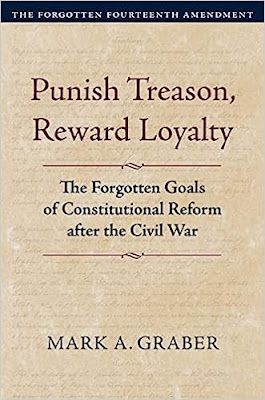
Mark A. Graber, Punish Treason, Reward Loyalty: The Forgotten Goals of Constitutional Reform after the Civil War (University of Kansas Press, 2023)
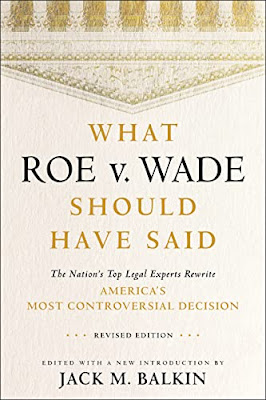
Jack M. Balkin, What Roe v. Wade Should Have Said: The Nation's Top Legal Experts Rewrite America's Most Controversial Decision - Revised Edition (NYU Press, 2023)

Andrew Koppelman, Burning Down the House: How Libertarian Philosophy Was Corrupted by Delusion and Greed (St. Martin’s Press, 2022)

Gerard N. Magliocca, Washington's Heir: The Life of Justice Bushrod Washington (Oxford University Press, 2022)
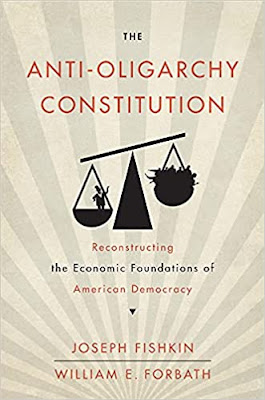
Joseph Fishkin and William E. Forbath, The Anti-Oligarchy Constitution: Reconstructing the Economic Foundations of American Democracy (Harvard University Press, 2022)

Mark Tushnet and Bojan Bugaric, Power to the People: Constitutionalism in the Age of Populism (Oxford University Press 2021).

Mark Philip Bradley and Mary L. Dudziak, eds., Making the Forever War: Marilyn B. Young on the Culture and Politics of American Militarism Culture and Politics in the Cold War and Beyond (University of Massachusetts Press, 2021).

Jack M. Balkin, What Obergefell v. Hodges Should Have Said: The Nation's Top Legal Experts Rewrite America's Same-Sex Marriage Decision (Yale University Press, 2020)

Frank Pasquale, New Laws of Robotics: Defending Human Expertise in the Age of AI (Belknap Press, 2020)

Jack M. Balkin, The Cycles of Constitutional Time (Oxford University Press, 2020)

Mark Tushnet, Taking Back the Constitution: Activist Judges and the Next Age of American Law (Yale University Press 2020).

Andrew Koppelman, Gay Rights vs. Religious Liberty?: The Unnecessary Conflict (Oxford University Press, 2020)

Ezekiel J Emanuel and Abbe R. Gluck, The Trillion Dollar Revolution: How the Affordable Care Act Transformed Politics, Law, and Health Care in America (PublicAffairs, 2020)

Linda C. McClain, Who's the Bigot?: Learning from Conflicts over Marriage and Civil Rights Law (Oxford University Press, 2020)
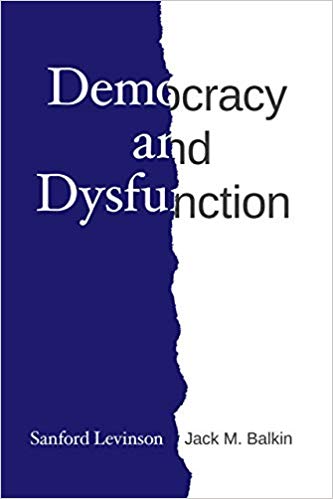
Sanford Levinson and Jack M. Balkin, Democracy and Dysfunction (University of Chicago Press, 2019)

Sanford Levinson, Written in Stone: Public Monuments in Changing Societies (Duke University Press 2018)

Mark A. Graber, Sanford Levinson, and Mark Tushnet, eds., Constitutional Democracy in Crisis? (Oxford University Press 2018)

Gerard Magliocca, The Heart of the Constitution: How the Bill of Rights became the Bill of Rights (Oxford University Press, 2018)

Cynthia Levinson and Sanford Levinson, Fault Lines in the Constitution: The Framers, Their Fights, and the Flaws that Affect Us Today (Peachtree Publishers, 2017)

Brian Z. Tamanaha, A Realistic Theory of Law (Cambridge University Press 2017)

Sanford Levinson, Nullification and Secession in Modern Constitutional Thought (University Press of Kansas 2016)

Sanford Levinson, An Argument Open to All: Reading The Federalist in the 21st Century (Yale University Press 2015)

Stephen M. Griffin, Broken Trust: Dysfunctional Government and Constitutional Reform (University Press of Kansas, 2015)

Frank Pasquale, The Black Box Society: The Secret Algorithms That Control Money and Information (Harvard University Press, 2015)

Bruce Ackerman, We the People, Volume 3: The Civil Rights Revolution (Harvard University Press, 2014)
Balkinization Symposium on We the People, Volume 3: The Civil Rights Revolution

Joseph Fishkin, Bottlenecks: A New Theory of Equal Opportunity (Oxford University Press, 2014)

Mark A. Graber, A New Introduction to American Constitutionalism (Oxford University Press, 2013)

John Mikhail, Elements of Moral Cognition: Rawls' Linguistic Analogy and the Cognitive Science of Moral and Legal Judgment (Cambridge University Press, 2013)

Gerard N. Magliocca, American Founding Son: John Bingham and the Invention of the Fourteenth Amendment (New York University Press, 2013)

Stephen M. Griffin, Long Wars and the Constitution (Harvard University Press, 2013)

Andrew Koppelman, The Tough Luck Constitution and the Assault on Health Care Reform (Oxford University Press, 2013)

James E. Fleming and Linda C. McClain, Ordered Liberty: Rights, Responsibilities, and Virtues (Harvard University Press, 2013)
Balkinization Symposium on Ordered Liberty: Rights, Responsibilities, and Virtues

Andrew Koppelman, Defending American Religious Neutrality (Harvard University Press, 2013)

Brian Z. Tamanaha, Failing Law Schools (University of Chicago Press, 2012)

Sanford Levinson, Framed: America's 51 Constitutions and the Crisis of Governance (Oxford University Press, 2012)

Linda C. McClain and Joanna L. Grossman, Gender Equality: Dimensions of Women's Equal Citizenship (Cambridge University Press, 2012)

Mary Dudziak, War Time: An Idea, Its History, Its Consequences (Oxford University Press, 2012)

Jack M. Balkin, Living Originalism (Harvard University Press, 2011)

Jason Mazzone, Copyfraud and Other Abuses of Intellectual Property Law (Stanford University Press, 2011)

Richard W. Garnett and Andrew Koppelman, First Amendment Stories, (Foundation Press 2011)

Jack M. Balkin, Constitutional Redemption: Political Faith in an Unjust World (Harvard University Press, 2011)

Gerard Magliocca, The Tragedy of William Jennings Bryan: Constitutional Law and the Politics of Backlash (Yale University Press, 2011)

Bernard Harcourt, The Illusion of Free Markets: Punishment and the Myth of Natural Order (Harvard University Press, 2010)

Bruce Ackerman, The Decline and Fall of the American Republic (Harvard University Press, 2010)
Balkinization Symposium on The Decline and Fall of the American Republic

Ian Ayres. Carrots and Sticks: Unlock the Power of Incentives to Get Things Done (Bantam Books, 2010)

Mark Tushnet, Why the Constitution Matters (Yale University Press 2010)
Ian Ayres and Barry Nalebuff: Lifecycle Investing: A New, Safe, and Audacious Way to Improve the Performance of Your Retirement Portfolio (Basic Books, 2010)
.jpg)
Jack M. Balkin, The Laws of Change: I Ching and the Philosophy of Life (2d Edition, Sybil Creek Press 2009)

Brian Z. Tamanaha, Beyond the Formalist-Realist Divide: The Role of Politics in Judging (Princeton University Press 2009)
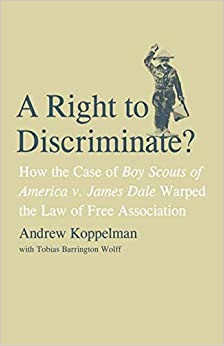
Andrew Koppelman and Tobias Barrington Wolff, A Right to Discriminate?: How the Case of Boy Scouts of America v. James Dale Warped the Law of Free Association (Yale University Press 2009)

Jack M. Balkin and Reva B. Siegel, The Constitution in 2020 (Oxford University Press 2009)
Heather K. Gerken, The Democracy Index: Why Our Election System Is Failing and How to Fix It (Princeton University Press 2009)

Mary Dudziak, Exporting American Dreams: Thurgood Marshall's African Journey (Oxford University Press 2008)

David Luban, Legal Ethics and Human Dignity (Cambridge Univ. Press 2007)

Ian Ayres, Super Crunchers: Why Thinking-By-Numbers is the New Way to be Smart (Bantam 2007)

Jack M. Balkin, James Grimmelmann, Eddan Katz, Nimrod Kozlovski, Shlomit Wagman and Tal Zarsky, eds., Cybercrime: Digital Cops in a Networked Environment (N.Y.U. Press 2007)

Jack M. Balkin and Beth Simone Noveck, The State of Play: Law, Games, and Virtual Worlds (N.Y.U. Press 2006)

Andrew Koppelman, Same Sex, Different States: When Same-Sex Marriages Cross State Lines (Yale University Press 2006)
Brian Tamanaha, Law as a Means to an End (Cambridge University Press 2006)
Sanford Levinson, Our Undemocratic Constitution (Oxford University Press 2006)
Mark Graber, Dred Scott and the Problem of Constitutional Evil (Cambridge University Press 2006)
Jack M. Balkin, ed., What Roe v. Wade Should Have Said (N.Y.U. Press 2005)
Sanford Levinson, ed., Torture: A Collection (Oxford University Press 2004)
Balkin.com homepage
Bibliography
Conlaw.net
Cultural Software
Writings
Opeds
The Information Society Project
BrownvBoard.com
Useful Links
Syllabi and Exams